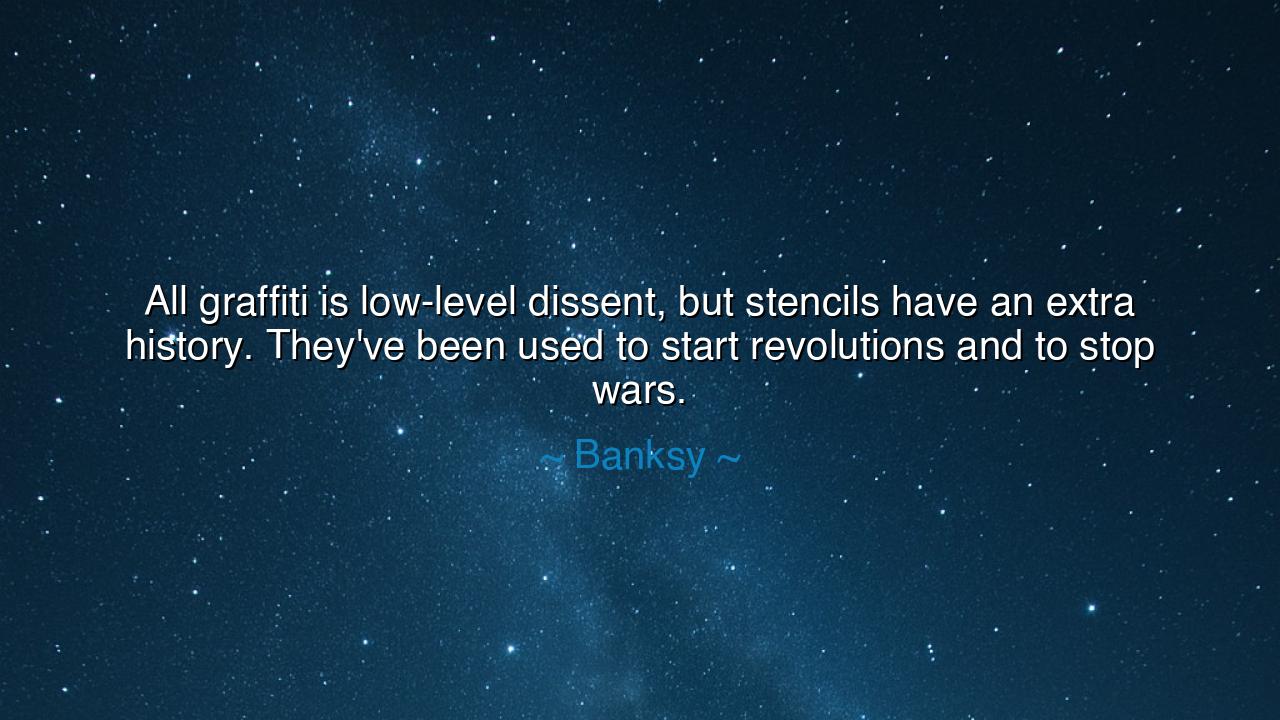
All graffiti is low-level dissent, but stencils have an extra
All graffiti is low-level dissent, but stencils have an extra history. They've been used to start revolutions and to stop wars.






“All graffiti is low-level dissent, but stencils have an extra history. They’ve been used to start revolutions and to stop wars.” – Banksy
Thus spoke Banksy, the masked poet of walls, the unseen prophet of the modern age, whose art blooms not in galleries but upon the gray stone of cities. In this quote, he reveals a truth that echoes through the corridors of history — that even the simplest mark upon a wall can become a weapon of spirit, a whisper of rebellion, a spark that sets the world aflame. For in every age, when power grows deaf and the powerful blind, the people find new ways to speak. Their words may be scrawled in haste, painted by night, carved into the bones of the city — but they endure. Graffiti, says Banksy, is the voice of the unheard, the pulse of dissent that refuses to die.
He calls it “low-level dissent,” not to diminish it, but to honor its humility. Unlike speeches or manifestos, graffiti does not demand a stage or microphone. It lives in the shadows, upon walls and bridges, in the corners of alleys and train cars — the places where truth hides when truth is forbidden. It is rebellion made intimate, resistance made human. Yet Banksy reminds us that among these markings, one form rises above the rest — the stencil, swift and repeatable, born of precision and purpose. For the stencil is not random expression; it is symbolic warfare, art with a cause, carrying a lineage that reaches far beyond paint and pavement.
The origin of the stencil is ancient. In the caves of early man, hunters blew pigment through hollow bones, tracing their hands upon the stone — the first human signatures, the first defiance against oblivion. Thousands of years later, soldiers of revolution used stencils to spread forbidden messages under cover of darkness. During the Second World War, in occupied France, the Résistance used stenciled slogans to defy the Nazi regime — simple, powerful words that could be made in seconds and multiplied a hundredfold before dawn. The oppressor controlled the press, the schools, the courts — but not the walls. The walls became the people’s paper, the stencils their press, their cries of freedom etched where none could silence them.
And in more recent times, these same symbols returned to life. When the Berlin Wall still stood, dividing a city and a people, it was graffiti that began to wear it down long before the hammers arrived. Painters covered its cold concrete with images of hope, peace, and protest, transforming it from a tool of oppression into a gallery of liberation. When it finally fell, those painted stones became relics — fragments of truth spoken by the common hand. Likewise, in the wars and revolutions of the twenty-first century, the stencil has again become a weapon of conscience. In the streets of Cairo, Hong Kong, and Tehran, artists have risked their lives to paint symbols of freedom. Their stencils, small and fleeting, have traveled farther and lived longer than armies.
Banksy, himself a modern heir to this ancient craft, knows that art is the last sanctuary of rebellion. His stencils — of doves with bulletproof vests, children embracing bombs, or soldiers painting peace signs — are not acts of vandalism, but of vision. Each one stands as a mirror, forcing the passerby to confront the hypocrisy of power. Through the simplicity of a stencil, Banksy channels the complexity of protest. His art asks no permission, for true dissent never does. It simply appears — like a voice from the stone, reminding the world that silence is not consent.
Yet, in his words lies a greater truth: that dissent itself is sacred, and that even the smallest act of defiance carries the weight of freedom. To protest is human; to express, divine. The stencil, in its humble power, teaches us that change begins not in palaces, but in hearts — and sometimes, on walls. The wise will see that every message, no matter how small, ripples outward. Each word painted in defiance, each image that confronts injustice, adds another stone to the long road toward liberty.
So, my child of the future, take this teaching into your soul: speak when others are silent; create when others destroy; resist not with hate, but with truth. You may not hold a sword or command an army, but you can still hold a brush, a pen, a voice. Make your mark, for even a wall can become scripture when written with conviction. Remember the wisdom of Banksy — that art and rebellion are eternal companions, and that from the quiet corners of cities, revolutions are born. The walls may crumble, but the stories they tell will echo forever, reminding every generation that freedom, like paint, cannot be washed away.






AAdministratorAdministrator
Welcome, honored guests. Please leave a comment, we will respond soon